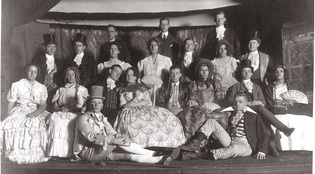 loading
loading
Gay at Yale Manuscripts & ArchivesMen regularly played women's roles in Yale theatrical productions—as in this 1910 cast photo—but beginning in 1915, a university regulation prohibited any man from playing a woman's role more than two years in a row. View full imageYale has a remarkably rich and revelatory queer history. I'll focus on the last 50 years rather than the first 250, so I won't begin by explaining, as I do in my lecture course, why New Haven was the most vindictive colony in all of British America in prosecuting sodomy -- executing two men in the 1640s not far from where Yale's Old Campus stands today. Instead, let me begin in the mid-nineteenth century, when Yale students lived in a very different emotional and erotic universe from ours, in which homosexuality and heterosexuality didn't yet exist as categories of sexual experience and identity. There are numerous diaries at Sterling Library from those years in which Yale students recorded their physical intimacy. Close friends sometimes slept together, not because they didn't have their own beds, and not necessarily to have sexual relations, but because sharing a bed was a sign that they had achieved the sort of intense friendship and emotional intimacy that students prized, and because sharing a bed was a way of deepening that intimacy. In 1858, for instance, Edward Sheffield regularly spent the night with his classmate and close friend Asher Wilcox. They didn't think of this as peculiar or queer; it variously seemed a fun, enriching, or emotionally charged thing to do. At the same time, the fact that many young men shared beds without being regarded as homosexual didn't mean the practice had the same meaning for all of them, or that none of them had distinctly erotic longings for other men. One of the striking features of these diaries is that they reveal some students worrying that their passionate attractions to other men surpassed the boundaries of normal, acceptable intimacy. Such intimacy was even more common among women. In 1873, for instance, a group of Yale men who'd visited Vassar complained about the phenomenon of women's "smashes" on other women, which produced such a level of devotion, even obsession, between them that it was hard for a Yale man to get noticed. And both Vassar women and Yale men, of course, regularly cross-dressed to play the parts of the other sex in their school productions. This began to change in the early twentieth century, as the categories of homosexuality and heterosexuality began to organize people's sexual lives, and as the newly constituted heterosexual majority anxiously began to police its borders by suppressing any signs of homosexuality. We can see the trend in a new regulation issued at Yale in 1915, which prohibited men in the Dramat from playing women's roles more than two years in a row. Men had to play these roles occasionally, of course, but female impersonation, which had long been a staple of family entertainment, was now beginning to be associated with sexual degeneration. We can also see the change more subtly in the shifting boundaries of physical intimacy considered acceptable among Yale men. In formal portraits of the football team from the late 1800s, the most striking thing to our eyes is the degree of physical intimacy between the men, who drape their arms over each other and put their hands on one another's shoulders, knees, and hearts. That closeness began to disappear in the early decades of the twentieth century. Men began to avoid such intimacy for fear of being called queer, and instead kept their arms, and their hands, carefully to their sides or on their own knees. Compare the football players in 1902, near the end of what we usually regard as the sexually repressive Victorian era, and in 1968, at the height of the sexual revolution, and you get a sense of how the new incitements to heterosexual intimacy were linked to the suppression of same-sex intimacy. And homosexuals.
|
|